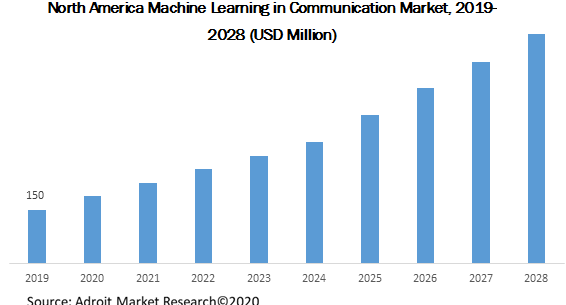The global Machine Learning in Communication market size is expected to reach close to USD 526.7 billion by 2029 with an annualized growth rate of 34.3% through the projected period.
.jpg)
The global machine learning in communication market size is anticipated to reach USD 4.2 billion by 2028. Adoption of intelligent communication designs, remarkable growth in data traffic, and advancements in technologies are some of the key reasons responsible for the industry growth are a few of the key factors anticipated to boost the industry growth in the coming years. Moreover, developments in technologies such as the Internet of Things (IoT), and big data are also fuelling the demand for machine learning in communication market growth.
Huge volumes of network data crossing networks on a routine basis. Machine language provides enhanced flexibility and know-how in network engineering services, operation, and management, thus maximizing network control and efficiency, thereby increasing the ultimate application of the computer language in communications and telecommunications. This development is due to machine learning as a crucial method for evaluating network and controlling traffic automation. With the advent of large-data analytics, network-rich metrics have been used to provide unprecedented analysis of The infrastructure.
Machine Learning In Communication Market Scope
| Metrics | Details |
| Base Year | 2023 |
| Historic Data | 2018-2022 |
| Forecast Period | 2024-2029 |
| Study Period | 2018-2029 |
| Forecast Unit | Value (USD) |
| Revenue forecast in 2029 | USD 526.7 billion |
| Growth Rate | CAGR of 34.3% during 2019-2029 |
| Segment Covered | Solution, By Application, End-use, Region. |
| Regions Covered | North America, Europe, Asia Pacific, South America, Middle East and Africa |
| Key Players Profiled | Advanced Micro Devices, Inc., ARM Ltd., Clarifai, Inc., Entilic, Google, Inc., HyperVerge, IBM Corporation, Intel Corporation |
Key Segment Of The Machine Learning in Communication Market
Solution, (USD Billion)
o Hardware
o Software
o Service
• Installation Services
• Integration Services
• Maintenance & Support Services
Hardware, (USD Billion)
• Central Processing Unit (CPU)
• Graphics Processing Unit (GPU)
• Field Programmable Gate Array (FPGA)
• Application-Specific Integration Circuit (ASIC)
Application, (USD Billion)
• Image Recognition
• Voice Recognition
• Video Surveillance & Diagnostics
• Data Mining
End-use, (USD Billion)
• Automotive
• Aerospace & Defense
• Healthcare
• Manufacturing
• Others
Regional Overview, (USD Billion)
North America
• US
• Canada
Europe
• Germany
• France
• UK
• Rest of Europe
Asia Pacific
• China
• India
• Japan
• Rest of Asia Pacific
South America
• Mexico
• Brazil
• Rest of South America
Middle East and South Africa
Frequently Asked Questions (FAQ) :
Moreover, machine learning methods are a core part of many emerging applications of communication technology. Machine learning and deep learning technologies are promising an end-to-end optimization of wireless networks while they commoditize PHY and signal-processing designs and help overcome RF complexities. Moreover, a learned communication system allows wireless designers to prioritize key design parameters such as throughput, latency, range, and power consumption.
Residential healthcare systems usually employ wearable devices, camera-based vision systems, and ambient sensors, but they entail drawbacks such as physical discomfort, privacy concerns, and limited detection accuracy. On the other hand, a passive Wi-Fi sensing system, based on activity recognition and through-wall respiration sensing, is contactless, accurate, and minimally invasive.
Deployment Type Segment
The global machine learning in the communication market is classified into cloud-based and on-premise. The cloud-based segment accumulated the largest market share in machine learning in the communication market in 2019. However, the on-premise segment is anticipated to witness a substantial growth rate over the forecast period.
Application Segment
Based on the application, the market is segmented into predictive maintenance, network optimization, robotic process automation (RPA), virtual assistants, and others. The market for robotic process automation (RPA) is anticipated to possess the largest market share in 2019 since the Tech companies today are predominantly developing the automation to match their user needs. Moreover, the growing regulatory scrutiny coupled with enhanced customer satisfaction, as well as advantages such as intelligent network management to improve situational awareness, improving network self-optimization and performance are some of the factors responsible for the machine learning in communication demand.
The global Machine Learning in Communication market is a wide range to North America, Europe, APAC, South America, and the Middle East & Africa. North America is considered a mature market in machine learning in communication applications, owing to the outsized presence of an organization with the availability of technical expertise and advanced IT infrastructure. The US and Canada are the highest contributory countries to the expansion of machine learning in the communication market in North America.

The major players of the global machine learning in the communication market are IBM, Cisco Nexmo, Google, Dialpad, Nextiva, Amazon, Microsoft, Twilio, RingCentral, and others. Machine learning in the communication market is fragmented with the existence of well-known global and domestic players across the globe.

